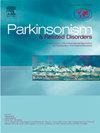Healthcare access and utilization of deep brain stimulation and supplementary care in black and white patients with Parkinson's disease
IF 3.4
3区 医学
Q2 CLINICAL NEUROLOGY
引用次数: 0
Abstract
Background
Information comparing healthcare access and utilization between Black and White patients with Parkinson's disease (PD), particularly for deep brain stimulation (DBS) and supplementary care, remains sparse due to the lack of large Black population in a majority of healthcare facilities and limited scope of information in electronic datasets. We hypothesized that Black PD patients are less likely to have implantation for DBS due to many reasons, including ones not explored yet such as a lower likelihood of being assessed for DBS and/or acceptance for DBS when indicated, but more likely to have supplementary care.
Methods
We searched electronic medical records in our tertiary center between January 1, 2006 and October 1, 2021, followed by chart reviewing and extracting demographics, socioeconomic status, comorbidities, and healthcare access and utilization, including medications, DBS and supplementary care. Of 2827 patients in records, 1211 were assessed by movement neurologists here, who verified the diagnosis in 882 of them (72.8 %). We included 846 patients (95.9 %) (Black/White 255/591) with needed information for analysis.
Results
Compared to White patients, Black patients lacked male predominance, had lower socioeconomic status, more comorbidities, and frequent care in emergency/inpatient settings. There was no difference in overall medication use, but Black patients were less likely to have implantation and evaluation for DBS, and to accept DBS when indicated, and more likely to have supplementary care.
Conclusions
Black patients are less likely to have DBS implantation, evaluation, and acceptance but more likely to have supplementary care compared to White patients. These new findings could help improve healthcare.
黑人和白人帕金森病患者脑深部电刺激和辅助治疗的可及性和利用
背景:比较黑人和白人帕金森病患者(PD)的医疗保健获取和利用情况的信息,特别是深部脑刺激(DBS)和辅助治疗,仍然很少,因为大多数医疗机构缺乏大量黑人人口,电子数据集的信息范围有限。我们假设,由于许多原因,黑人PD患者不太可能植入DBS,其中包括一些尚未探索的原因,例如在指诊时接受DBS评估和/或接受DBS的可能性较低,但更有可能接受补充治疗。方法检索我院三级中心2006年1月1日至2021年10月1日的电子病历,进行图表回顾,提取人口统计学、社会经济状况、合并症、医疗保健可及性和利用情况,包括药物、DBS和辅助治疗。在记录的2827例患者中,1211例由这里的运动神经科医生评估,其中882例(72.8%)确诊。我们纳入了846例患者(95.9%)(黑人/白人255/591),这些患者需要的信息用于分析。结果与白人患者相比,黑人患者缺乏男性优势,社会经济地位较低,合并症较多,急诊/住院次数较多。总体用药方面没有差异,但黑人患者接受DBS植入和评估的可能性较小,在有指示时接受DBS的可能性较小,接受补充治疗的可能性较大。结论与白人患者相比,黑人患者接受DBS植入、评估和接受的可能性较小,但接受辅助治疗的可能性较大。这些新发现有助于改善医疗保健。
本文章由计算机程序翻译,如有差异,请以英文原文为准。
求助全文
约1分钟内获得全文
求助全文
来源期刊

Parkinsonism & related disorders
医学-临床神经学
CiteScore
6.20
自引率
4.90%
发文量
292
审稿时长
39 days
期刊介绍:
Parkinsonism & Related Disorders publishes the results of basic and clinical research contributing to the understanding, diagnosis and treatment of all neurodegenerative syndromes in which Parkinsonism, Essential Tremor or related movement disorders may be a feature. Regular features will include: Review Articles, Point of View articles, Full-length Articles, Short Communications, Case Reports and Letter to the Editor.
 求助内容:
求助内容: 应助结果提醒方式:
应助结果提醒方式:


